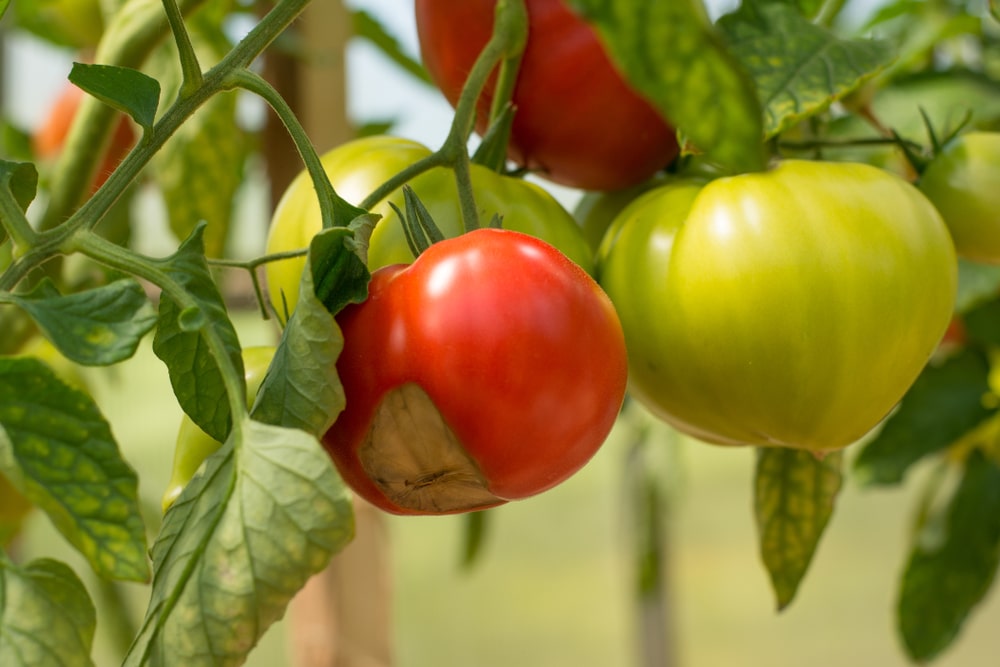I’ve had so many customers come in recently with tomatoes in their hands or pictures of tomatoes on their phones because they have a problem with the fruit. With so many customers having tomato-growing challenges, I’m reposting this updated blog from last summer.
If you’re growing tomatoes, here is a list of what you may find, the cause, and how to address the problem.
Blossom End Rot
These are black water-soaked lesions at the bottom of the fruit. It is caused by a calcium deficiency—but it may or may not be due to a lack of calcium in the soil. Other factors that can affect a plants uptake of calcium may be:
- Planting too soon. If you plant when soil temperatures are below 65 or so it can affect the plant’s ability to uptake nutrients from the soil.
- Using a high nitrogen fertilizer. Use a fertilizer with more phosphorus than nitrogen. Tomato-tone by Espoma is my favorite fertilizer, but if it isn’t available, then Flower-tone or Garden-tone is good.
- Inconsistencies in soil moisture. Never ever let a tomato go so dry it begins to droop, but, also never water if the soil is still dark and moist to the touch.
- Soil pH that is too alkaline. Get your soil checked. Tomatoes prefer soil with a pH of 6.0 to 7.0.
Cat-Facing
Cat facing is a disorder that causes deformities on the bottom of the tomato—scar tissue-filled cracks, abnormal cavities, small swollen bulges. The exact reason why this happens is not known, but it does seem to center around environmental stresses that can cause incomplete pollination. Possible causes:
- Planting too soon, when soil temperatures are too cold
- Excessive heat and humidity.
- Inconsistent watering.
Cracking
Cracks in the stem end of the tomato. This is usually caused by inconsistent watering. Heirloom tomatoes, particularly beefsteak types, seem to be more prone to both cat-facing and cracking.
Not setting fruit
One annoying thing about tomatoes is they often stop setting fruit when daytime temperatures are over the low nineties. While tomatoes are self-pollinating, in excessive heat and humidity, the pollen can degrade so it “clumps” making it difficult to self-pollinate.
Mulch around the roots with an “airy” mulch-like straw to keep moisture even and keep the roots cooler. Do NOT feed during excessive heat! Plants don’t want to be forced to grow when they are under weather stress. Otherwise, just be patient and wait it out. The tomatoes will resume self-pollinating when the weather is more to their liking.
Fruits with holes eaten in them
This can be caused by one of two things—birds or squirrels. I’ve actually seen cardinals perched on the sides of my tomato cages pecking the heck out of the ripe tomatoes. You can try bird-netting, but I don’t like it. Sometimes small critters can get caught in it. I just pick the tomato when it’s “mostly” ripe and let it finish on the windowsill. Also, provide a water source elsewhere.
If you’re finding green tomatoes with one bite missing, that is likely squirrels looking for the moisture content. The cure is simple—spray green tomatoes with a repellent—like Hot Pepper Wax (an extract of cayenne pepper), and provide an EASILY accessible water source 10 to 15 feet away—a birdbath or saucer filled with water.
It’s a matter of survival though—if you don’t provide a water source, they’ll go after the tomato anyway.
Let Us Help You
If you’re having a weird problem with your tomatoes, come in and let us help. As a matter of fact, if you are having ANY gardening problem, stop by and let us help you solve it. That’s why we’re here!


Saving your egg shells and crushing them so they are very small, then add to the tomato garden soil. Free calcium.
Hi Bob–Yeah, eggshells are a good source of calcium–in a few decades after they have broken down into their elemental form. The problem is they are NOT a quick solution.
Thank you for the tips
Why are
My tomatoe leaves yellowing and withering? The fruit does not seem to be affected
Marina–there are a number of diseases that can affect tomato–early blight, late blight, fusarium, verticillium, etc. Unfortunately, there are few to none effective treatments for them. My best advice is to not plant another tomato family member there for three years–no tomatoes, potatoes, peppers or eggplant because the disease can linger in the soil for up to three years. Plant tomato family elsewhere. You can plant cucumbers, squash, green beans, etc. because they are not prone to the same diseases that attack tomato family members.
My squash produce lots of flowers but no squash. Help!
Bruce–squash, melons and cucumber flowers have to be pollinated in order to set fruit. Tomatoes, peppers and eggplant are self-pollinating. You may need to step in and hand-pollinate. Pick a male flower first thing in the morning (a male flower is the one with NO baby fruit at the base. Peel off the petals, then take the flower and dab it gently into the middle of the female flowers (the ones that do have the baby fruit at the base.) That should solve your problem.